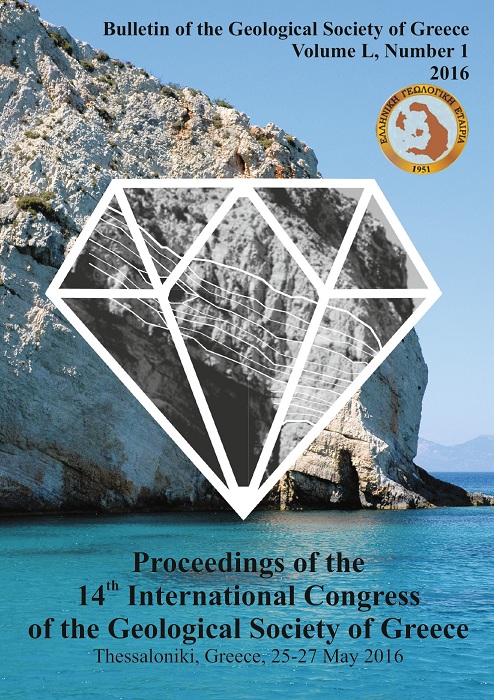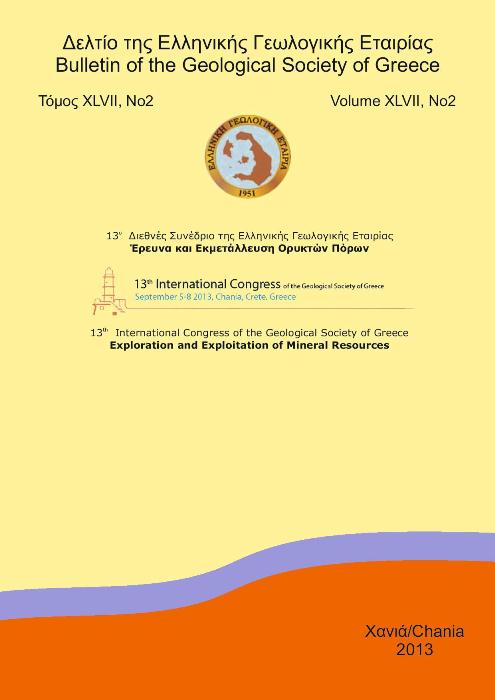Reconstructing concealed cultural remains through integrated geophysical tomographic methods.

Περίληψη
Σκοπός της εργασίας είναι να συγκρίνει τα αποτελέσματα της χαρτογράφησης θαμμένων αρχαιολογικών δομών από μία περιοχή στους Δελφούς με τις μεθόδους της ηλεκτρικής και σεισμικής τομογραφίας και τη μέθοδο του Γεωραντάρ. Για την συλλογή των περίπου 1752 χρόνων διαδρομής των επιμήκων κυμάτων, τοποθετήθηκαν 24 γεώφωνα σε μία περιοχή που κάλυπτε μία έκταση 50x40 μέτρα και πραγματοποιήθηκαν 73 κρούσεις μέ ένα σφυρί πάνω σε μεταλλική επιφάνεια. Τα δεδομένα της τρισδιάστατης ηλεκτρικής τομογραφίας συλλέχθηκαν κατά μήκος πυκνών παράλληλων γραμμών με την διάταξη πόλου-διπόλου όπου η απόσταση μεταξύ των τομών ήταν 1 μέτρο. Η χωρική ανάλυση παράλληλων τομών για τα δεδομένα του γεωραντάρ ήταν 0,5 μέτρα. Τα γεωηλεκτρικά και σεισμικά δεδομένα επεξεργάστηκαν με αλγόριθμους τρισδιάστατης μη-γραμμικής αντιστροφής με σκοπό την ανακατασκευή τρισδιάστατων μοντέλων αντίστασης και ταχύτητας. Τα μοντέλα αυτά περιγράφουν την χωρική κατανομή των αρχαιολογικών λειψάνων μέσα στο υπέδαφος αλλά και τα επιφανειακά γεωλογικά στρώματα μέχρι το βάθος των 5 μέτρων από την επιφάνεια. Επιπλέον τα σήματα του γεωραντάρ ενισχύθηκαν με την εφαρμογή συγκεκριμένων φίλτρων με σκοπό την ενίσχυση της αρχαιολογικής πληροφορίας μέχρι το βάθος των δύο μέτρων από την επιφάνεια του εδάφους. Η συνδυαστική ερμηνεία των γεωφυσικών αποτελεσμάτων δείχνει την ύπαρξη αρχιτεκτονικών δομών μέσα σε ένα αργιλικό περιβάλλον. Τα αποτελέσματα δείχνουν γενικά τη σημασία των τομογραφικών γεωφυσικών μεθόδων προς την κατεύθυνση της πιο ολοκληρωμένης αποτύπωσης των φυσικών ιδιοτήτων του υπεδάφους στο πλαίσιο αρχαιολογικών προσεγγίσεων και της διατήρησης της πολιτισμικής κληρονομιάς . Λέξεις κλειδιά: Ηλεκτρική τομογραφία, σεισμική τομογραφία, γεωραντάρ, 3D, Δελφοί.
Λεπτομέρειες άρθρου
- Πώς να δημιουργήσετε Αναφορές
-
Soupios, P., Papadopoulos, N., & Sarris, A. (2013). Reconstructing concealed cultural remains through integrated geophysical tomographic methods. Δελτίο της Ελληνικής Γεωλογικής Εταιρείας, 47(3), 1260–1268. https://doi.org/10.12681/bgsg.10900
- Ενότητα
- Γεωφυσική και Σεισμολογία

Αυτή η εργασία είναι αδειοδοτημένη υπό το CC Αναφορά Δημιουργού – Μη Εμπορική Χρήση 4.0.
Οι συγγραφείς θα πρέπει να είναι σύμφωνοι με τα παρακάτω: Οι συγγραφείς των άρθρων που δημοσιεύονται στο περιοδικό διατηρούν τα δικαιώματα πνευματικής ιδιοκτησίας επί των άρθρων τους, δίνοντας στο περιοδικό το δικαίωμα της πρώτης δημοσίευσης. Άρθρα που δημοσιεύονται στο περιοδικό διατίθενται με άδεια Creative Commons 4.0 Non Commercial και σύμφωνα με την οποία μπορούν να χρησιμοποιούνται ελεύθερα, με αναφορά στο/στη συγγραφέα και στην πρώτη δημοσίευση για μη κερδοσκοπικούς σκοπούς. Οι συγγραφείς μπορούν να: Μοιραστούν — αντιγράψουν και αναδιανέμουν το υλικό με κάθε μέσο και τρόπο, Προσαρμόσουν — αναμείξουν, τροποποιήσουν και δημιουργήσουν πάνω στο υλικό.






